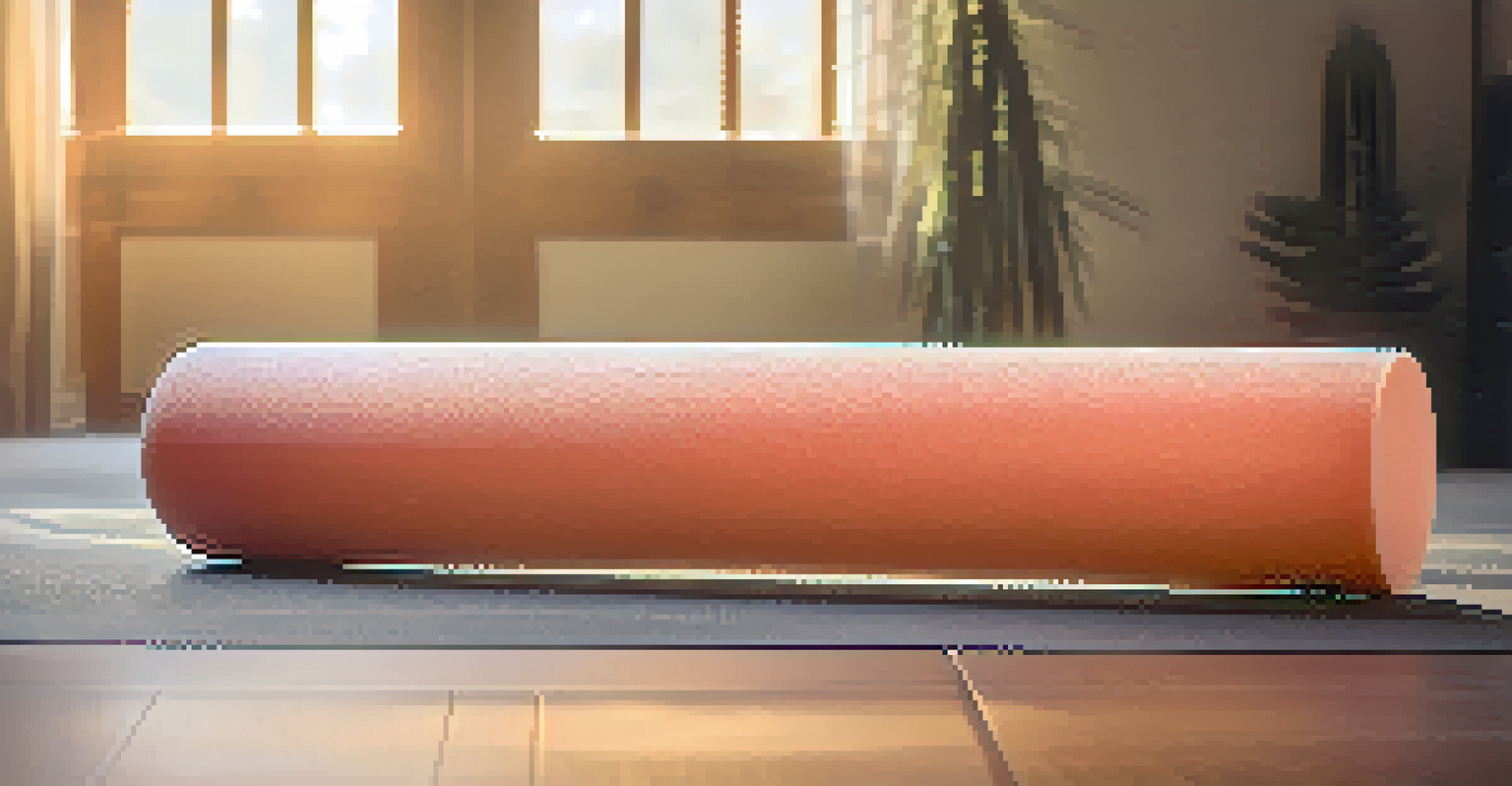Utilizing Foam Rollers for Enhanced Bodybuilding Recovery

Understanding the Importance of Recovery in Bodybuilding
Recovery is an essential component of bodybuilding that often gets overlooked. It’s during this time that your muscles repair and grow stronger, making it critical to incorporate effective recovery techniques into your routine. Without proper recovery, you risk injuries and can hinder your progress, turning gains into setbacks.
The only way to achieve the impossible is to believe it is possible.
Foam rolling is one such technique that helps facilitate this recovery process. By improving blood flow and reducing muscle soreness, foam rolling can help you bounce back more quickly after intense workouts. Think of it as giving your muscles a gentle massage, helping them relax and repair efficiently.
Ultimately, understanding the importance of recovery can transform your bodybuilding journey. When you prioritize recovery through methods like foam rolling, you set yourself up for sustainable progress and long-term success in your fitness goals.
What is Foam Rolling and How Does it Work?
Foam rolling involves using a cylindrical foam tool to apply pressure on your muscles, helping to release tension and improve flexibility. This self-myofascial release technique can feel a bit uncomfortable at first, but it’s an effective way to break down knots in your muscles. Imagine using a rolling pin on dough; foam rolling smooths out tight spots and helps your muscles return to their optimal state.

When you roll out your muscles, you’re essentially sending messages to your nervous system that can help alleviate pain and improve mobility. This process increases blood circulation, delivering oxygen and nutrients to your tissues, which is vital for recovery after an intense workout. The more you use foam rollers, the more you'll appreciate how they can enhance your workout performance.
Recovery is Key to Bodybuilding Success
Prioritizing recovery, such as through techniques like foam rolling, is essential for muscle repair and long-term progress.
In essence, foam rolling is like a tune-up for your body, helping to maintain optimal muscle function. By incorporating this practice into your routine, you can experience a range of benefits that contribute to improved performance and faster recovery.
How to Choose the Right Foam Roller for Your Needs
Selecting a foam roller can be a bit overwhelming with all the options available. Generally, foam rollers come in various densities, sizes, and textures, each offering unique benefits. A softer roller is great for beginners or those with sensitive muscles, while a firmer option can provide deeper pressure for more intense muscle knots.
Strength does not come from physical capacity. It comes from an indomitable will.
Consider your specific needs when choosing a foam roller. If you're focusing on targeted muscle groups, a smaller, more rigid roller might be the best choice. On the other hand, a larger roller can be effective for broader areas like your back or thighs, allowing for a more comprehensive rolling experience.
Ultimately, the right foam roller for you should feel comfortable and effective. Don’t hesitate to try out a few different types to discover what works best for your body and recovery needs.
Incorporating Foam Rolling Into Your Workout Routine
Adding foam rolling to your workout routine is simple and can be done at various times. Many bodybuilders find it beneficial to roll out both before and after their workouts. Rolling before exercising helps warm up the muscles, while post-workout rolling aids in reducing soreness and speeding up recovery.
As a rule of thumb, spend about 1-2 minutes on each muscle group, focusing on areas of tightness. Use slow, controlled movements to allow your muscles to adapt to the pressure. This practice not only enhances recovery but can also improve your overall performance by increasing flexibility and range of motion.
Foam Rolling Enhances Muscle Recovery
Foam rolling alleviates soreness, improves flexibility, and promotes relaxation, making it a valuable tool for muscle recovery.
The key is to listen to your body as you roll. If you find a particularly tight spot, spend extra time there, allowing the muscle to release. With consistent practice, you'll likely notice a significant improvement in your recovery and workout results.
Common Mistakes to Avoid When Foam Rolling
While foam rolling can be incredibly beneficial, it’s important to approach it correctly to avoid injury. One common mistake is rolling too quickly over the muscles. Instead, take your time and allow pressure to build gradually; this will enhance the effectiveness of the foam rolling session.
Another mistake is focusing only on sore areas while neglecting other muscle groups. It's crucial to maintain a balanced approach, as tightness in one area can affect overall body mechanics. By rolling out various muscle groups, you promote better blood flow and recovery throughout your entire body.
Lastly, don’t forget to breathe! Many people hold their breath when they encounter discomfort, which can increase tension in the muscles. Instead, focus on deep, steady breathing to help your body relax and make the most of each foam rolling session.
Benefits of Foam Rolling for Muscle Recovery
Foam rolling offers a myriad of benefits that can significantly enhance muscle recovery. Firstly, it helps alleviate soreness, allowing you to feel more comfortable and ready for your next workout. This is especially important for bodybuilders who often push their limits and experience post-workout discomfort.
In addition to reducing soreness, foam rolling can improve flexibility and range of motion. By regularly rolling out tight muscles, you encourage better muscle elasticity, which can lead to improved performance. Think of it like oiling a squeaky door; it helps everything move more smoothly.
Choose the Right Foam Roller
Selecting the appropriate foam roller based on density and size can significantly impact your recovery experience.
Lastly, foam rolling can promote relaxation and decrease stress levels. The act of taking time to care for your muscles not only benefits your body but also your mind, making it a holistic approach to recovery that supports both physical and mental well-being.
Final Thoughts on Foam Rolling in Bodybuilding Recovery
Incorporating foam rolling into your bodybuilding routine can be a game-changer for recovery. It’s a simple yet effective practice that can lead to improved performance, reduced soreness, and overall better muscle function. By understanding how to use foam rollers correctly, you can maximize your gains and minimize setbacks.
Remember that recovery is just as crucial as your training sessions. Making foam rolling a regular part of your routine can help you maintain your momentum and achieve your bodybuilding goals more efficiently. Think of it as an investment in your body’s future.

So, grab a foam roller and start rolling! Your muscles will thank you, and you’ll likely notice a difference in your recovery and performance as you continue to incorporate this technique into your bodybuilding journey.